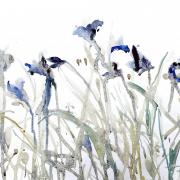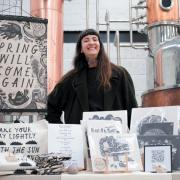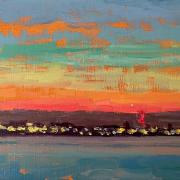John Green’s precise dockyard paintings show the traditional role of Hampshire’s historic coastal city says Sandra Smith

There’s something chaotically comforting about John Green’s studio. In the same way that an extended family gathering highlights as many individual characteristics as parallel genetic traits, the hub of this artist’s life features generations of paintings jostling for attention in an ongoing reminder of fledgling styles, evolving subjects and mature brushwork.
In addition, every aspect of his work is visible and defies orderliness. Brushes? Scattered around on shelves and next to aluminium plates over by a printing press. Mountboards? Hmm, somewhere nearby - ah yes, stacked against a cupboard overflowing with part used tubes of paint. Sketches, early abstracts and watercolours dating back a decade or more? Covering all available wall space.
If I’m giving the impression of a degree of disarray, that’s intentional. Creativity, after all, can’t be filed in a drawer to await a prearranged appointment. Nor do tidy, organised surfaces equate to originality or spontaneity or vision, all of which are crucial to an artist.
So on all counts John’s studio matches my expectations. What I’d underestimated, and evident from the moment I enter the second largest room at Art Space Portsmouth, is the range and skill of this multi talented artist. As expected, industry and manual labour resonate throughout much of his popular work, yet also visible are abstracts and watercolours bordering on fantasy.
“Stanley Spencer is my favourite artist. I did some early abstract work but after a time an art teacher suggested I concentrate on the dockyard. I’d joined Portsmouth Docks as a rigger when I left school at 15. This involved climbing masts to put new rigging up so you had to be fit to do the job and have common sense, too.”
The reality of manual labour is imprinted on John’s photographic memory. Yet though his images reflect an era from past decades, their presentation is current. Brightness of acrylics contributes to the contemporary mood along with blocks of colour and simplicity of style, none of which detract from the effort of the work involved. Evident in Running The Docker And Propeller are reminders of the slog of a physically challenging working environment - similarly, Working On The Sluicegate conjures up exertion and breathlessness.
Equally intriguing in this series is the workers’ attire, details of which the artist readily summons.
“I can remember the colour of the dockies’ overalls,” John reflects. “And a dockie always had his tin of tobacco. My father kept a cabbage leaf in his tin to keep the tobacco fresh. The men I worked with were all ex servicemen. The Master Rigger was a naval officer. When he spoke to me about how I was getting on he said I was very good and doing the right thing by keeping myself to myself. The other men wouldn’t want any young whippersnapper arguing with them.”

John’s artistic skills were already apparent by this stage. In school art was the subject at which he excelled. While growing up, he became aware of an expectation to leave education at 15 but continued to “scribble during free time” during which he accumulated numerous small books of sketches. It was an interest which eventually caught the eye of his employer. John reaches for a folder when explaining that, four years before retirement, he was asked to create a Mast and Yard Rigging Book.
Such is the minutiae and delicacy of these scaled drawings, they could easily have been created by an architect, engineer or illustrator. I’m as effusive in my praise as John is unfazed. His talent, it seems, is something he takes in his stride. So I’m intrigued to learn how, after decades in the dockyards, his art career developed.
“When I came out of the yard in 1996 I didn’t know what to do with myself. But I went to night classes. People thought I was an art teacher coming back to be retrained but it was just normal to me. I was advised to get my own studio. I didn’t know how to go about it until someone suggested Art Space which I hadn’t heard of. It was like trying to get into Fort Knox! I had to supply a portfolio of work which kept me busy, then I joined a waiting list for a year and a half. My first room was quite small but it was mine. You pay rent according to size. You have to use the studio regularly. I’m here most days, Monday to Friday.”
This upstairs studio has one window – John dismisses the fuss artists make about natural light – and camaraderie amongst fellow artists here offers opportunities for discussion and sharing of information. The building, originally a United Methodist Bible Christian Church, was built in 1905 and acquired by Portsmouth Polytechnic graduates and lecturers in 1980, resulting in the formation of Art Space. The organisation may be situated in a quiet, residential location yet it nurtures a wealth of creative talent packed into this locally designed structure.
Whilst I’m exploring the room and admiring early abstract pictures, sketches and figures - some of which conjure up visions of Egyptian and aboriginal art - John tells me he favours acrylics because of their ability to dry fast. He is a member of Portsmouth and Hampshire Art Society, and welcomes visitors as long as they phone beforehand. He produces dry point etchings on aluminium plates and his first one man show was held earlier this year at Jack House Gallery in Old Portsmouth.
Rebecca Crow, Gallery owner, stresses the impact of John’s work. “The first show not only attracted art lovers but ex dockies, boiler makers, joiners, riggers and the first female shipwright. I even had people from the old payroll department telling stories about paying the men when they’d been made redundant. It was amazing how important the yard was to so many lives. I believe a great many of the people who came had never before been into a gallery - somehow John’s work crossed a divide.”
John Green isn’t overtly demonstrative and his responses to my questions are minimal. He is, nevertheless, emphatic in his approach.
“My work has progressed a lot. If someone had asked me years ago to paint a 4’ x 4’ picture I couldn’t, but now it’s a different ball game - large paintings don’t frighten me. Painting gives me a lot of satisfaction. I’m not frightened to carry on with my work.”
A commitment to painting and gratitude to Art Space Portsmouth enable this artist to regularly hone his skills within his own studio. Perhaps a lifetime’s toil in the dockyards has also influenced the 75 year old’s no nonsense attitude since daily work isn’t burdensome. Indeed, he asserts, “No one can be a weekend painter. I don’t get it at all.”
I take a final opportunity to absorb the rawness of John’s dockyard images, in particular the scale of ships and carefully assembled cast of workers. Going beyond colourful canvases, further even than a reminder of a long lost industry, I leave marvelling at the impact of these precise paintings in which is embedded the artistry of one Portsmouth septuagenarian and the traditional role of Hampshire’s historic coastal city.
More…
• Jeremy Houghton: Artist in Residence for the British America’s Cup Team - Artist in Residence for Team BAR, Jeremy Houghton discusses the alliance of art and sport with Sandra Smith
• Hampshire art group Just Four - Each individual artists in their own right, it isn’t until these four Hampshire women come together that their true creativity sparks. Sandra Smith pays art group, Just Four a visit to learn more about mixing working with pleasure



























